Global Contraction and Local Strengthening of Firms’ Supply and Sales Logistics Networks in the Context of COVID-19: Evidence from the Development Zones in Weifang, China
Abstract
1. Introduction
1.1. Background
1.2. Literature Review
1.3. Aims and Questions
1.4. Research Framework
2. Materials and Methods
2.1. Study Area
2.2. Methodology
2.2.1. Two-Mode Network
2.2.2. Network Centrality Analysis
- Degree Centrality
- Closeness Centrality
- Betweenness Centrality
2.2.3. Analysis Steps
2.3. Data Resources
3. Results
3.1. Structure of Firms’ Logistics Networks before the Outbreak of the Pandemic
3.1.1. Supply Logistics Networks
3.1.2. Sales Logistics Networks
3.2. Changes to Firms’ Logistics Networks after the Outbreak of the Pandemic
3.2.1. Changes to Supply Logistics Networks
3.2.2. Changes to Sales Logistics Networks
3.2.3. Changes in Firms’ Logistics Linkage Frequencies at Different Geographical Scales
4. Analysis of Influencing Factors
4.1. Overseas and Domestic Influencing Factors
4.2. Local Influencing Factors
5. Discussion and Conclusions
5.1. Discussion
5.2. Conclusions
Author Contributions
Funding
Data Availability Statement
Conflicts of Interest
Appendix A
- According to the data released by the Chinese National Bureau of Statistics, the throughput of China’s foreign trade cargo ports increased by 1.3%, 0.3%, and –0.6% (8.2% in November 2019), and the national freight volume was down by 17.0%, 29.9%, and 13.0%, from January to March 2020, when the pandemic was at its height in China.
- According to the China Development Zone Audit Announcement List 2018, there are 2718 national and provincial development zones in China. The publication of Main Economic Indicators for the Economic and Technological Development Areas in China (2019) shows that 218 national economic and technological development zones contributed 10.9% of China’s fiscal revenue, 17.4% of the added value of the secondary industry, and 19.9% of total imports and exports. These proportions would be higher if the provincial development zones were considered.
- The surveyed companies were required to fill in the countries/regions of their supply originations or sales destinations when the questionnaires were distributed. According to the questionnaire results, the overseas countries/regions are divided into 11 spatial units: Southeast Asia, Europe, Africa, Middle East, North America, South America, India, Oceania, Mongolia, Japan, and South Korea.
- As China controlled the spread of COVID-19 in March 2020, reducing the number of daily new confirmed cases from 15,153 cases, with the peak on 12 February 2020, to below 100 on average, manufacturing companies in China are gradually resuming production. As of 1 December 2020, the number of daily new confirmed cases overseas was still high—between 500,000 and 600,000. The questionnaire survey in the study was conducted when the pandemic was initially controlled in China, but still severe overseas.
- Interviews with companies in the Shandong Weifang Economic and Technological Development Zone (Shandong Weiyuan New Material Equipment Co., Ltd., Shandong, China) were conducted on 26 August 2020.
- According to the data released by the Chinese National Bureau of Statistics, the throughput of China’s foreign trade cargo ports increased by 1.3%, 0.3%, and –0.6% (8.2% in November 2019) in January, February, and March 2020, respectively, when the pandemic was at its height.
- A questionnaire survey and field visits to the companies in the development zones showed that 56.8% of the surveyed companies mentioned the increase in logistical and transportation costs during the outbreak of COVID-19.
- A questionnaire survey and field visits to the companies in the development zones showed that nearly half (46.6%) of the surveyed companies hope to find raw material suppliers in the neighboring provinces or their own province after the outbreak of COVID-19.
- According to the field survey, the surveyed companies are not inclined to limit the sales target market to the neighboring regions. Compared to the 46.6% of the surveyed companies that hope to find raw material suppliers in the neighboring provinces, only 22.73% hope to locate their target market in the neighboring provinces. This also confirms why the space contraction of the sales logistics network is not as significant as that of the supply logistics network.
References
- Ye, X. Logisitics cost management based on ABC and EVA integrated mode. In Proceedings of the 2011 IEEE International Conference on Automation and Logistics (ICAL), Chongqing, China, 15–16 August 2011; pp. 261–266. [Google Scholar] [CrossRef]
- Hobbs, J.E. Food supply chains during the COVID-19 pandemic. Can. J. Agric. Econ. 2020, 68, 171–176. [Google Scholar] [CrossRef]
- Singh, S.; Kumar, R.; Panchal, R.; Tiwari, M. Impact of COVID-19 on logistics systems and disruptions in food supply chain. Int. J. Prod. Res. 2020, 59, 1–16. [Google Scholar] [CrossRef]
- Aday, S.; Aday, M.S. Impact of COVID-19 on the food supply chain. Food Qual. Saf. 2020, 4, 167–180. [Google Scholar] [CrossRef]
- Paul, S.K.; Chowdhury, P. A production recovery plan in manufacturing supply chains for a high-demand item during COVID-19. Int. J. Phys. Distrib. Logist. Manag. 2021, 51, 104–125. [Google Scholar] [CrossRef]
- Liu, W.; Liang, Y.; Bao, X.; Qin, J.; Lim, M. China’s logistics development trends in the post COVID-19 era. Int. J. Logist. Res. Appl. 2020, 1–12. [Google Scholar] [CrossRef]
- Lu, L.; Peng, J.; Wu, J.; Lu, Y. Perceived impact of the Covid-19 crisis on SMEs in different industry sectors: Evidence from Sichuan, China. Int. J. Disaster Risk Reduct. 2021, 55, 102085. [Google Scholar] [CrossRef]
- Thadakamaila, H.; Raghavan, U.; Kumara, S.; Albert, R. Survivability of multiagent-based supply networks: A topological perspect. IEEE Intell. Syst. 2004, 19, 24–31. [Google Scholar] [CrossRef]
- Hall, P.; Hesse, M. Cities, Regions and Flows; Routledge: Oxford, UK, 2013; pp. 75–88. [Google Scholar]
- Hanson, S. The Geography of Urban Transportation, 3rd ed.; Guilford: New York, NY, USA, 1995. [Google Scholar]
- Hoyle, B.; Knowles, R. Modern Transport Geography, 2nd ed.; Wiley: London, UK, 1998. [Google Scholar]
- O’Kelly, M. A geographer’s analysis of hub-and-spoke networks. J. Transp. Geogr. 1998, 6, 171–186. [Google Scholar] [CrossRef]
- McKinnon, A. Logistical restructuring, freight traffic growth and the environment. In Transport Policy and the Environment; Routledge: Oxford, UK, 1998; pp. 97–109. [Google Scholar]
- Riemers, C. Functional relations in distribution channels and location patterns of the dutch wholesale sector. Geogr. Ann. B 1998, 80, 83–100. [Google Scholar] [CrossRef]
- Kengpol, A. Design of a decision support system to evaluate logistics distribution network in Greater Mekong Subregion Countries. Int. J. Prod. Econ. 2008, 115, 388–399. [Google Scholar] [CrossRef]
- Salema, M.I.G.; Barbosa-Povoa, A.; Novais, A.Q. An optimization model for the design of a capacitated multi-product reverse logistics network with uncertainty. Eur. J. Oper. Res. 2007, 179, 1063–1077. [Google Scholar] [CrossRef]
- Alumur, S.A.; Nickel, S.; Saldanha-Da-Gama, F.; Verter, V. Multi-period reverse logistics network design. Eur. J. Oper. Res. 2012, 220, 67–78. [Google Scholar] [CrossRef]
- Droździel, P.; Wińska, M.; Madleňák, R.; Pawe, S. Optimization of the post logistics network and location of the local dis-tribution center in selected area of the Lublin province. Procedia Eng. 2017, 192, 130–135. [Google Scholar] [CrossRef]
- Guo, J.; Wang, S.; Wang, D.; Liu, T. Spatial structural pattern and vulnerability of China-Japan-Korea shipping network. Chin. Geogr. Sci. 2017, 27, 697–708. [Google Scholar] [CrossRef]
- Ducruet, C.; Lee, S.; Ng, A. Centrality and vulnerability in liner shipping networks: Revisiting the Northeast Asian port hi-erarchy. Mar. Policy Manag. 2010, 37, 17–36. [Google Scholar] [CrossRef]
- Li, Z.; Xu, M.; Shi, Y. Centrality in global shipping network basing on worldwide shipping areas. GeoJournal 2015, 80, 47–60. [Google Scholar] [CrossRef]
- Gong, Q.; Wang, K.; Fan, X.; Fu, X.; Xiao, Y.-B. International trade drivers and freight network analysis—The case of the Chinese air cargo sector. J. Transp. Geogr. 2018, 71, 253–262. [Google Scholar] [CrossRef]
- Dai, L.; Derudder, B.; Liu, X. The evolving structure of the Southeast Asian air transport network through the lens of complex networks, 1979–2012. J. Transp. Geogr. 2018, 68, 67–77. [Google Scholar] [CrossRef] [PubMed]
- Zhong, Y.; Lu, Y. Hierarchical structure and distribution pattern of Chinese urban system based on railway network. Geogr. Res. 2011, 30, 785–794. [Google Scholar]
- Wang, J.E.; Jing, Y. Comparison of spatial structure and organization mode of inter-city networks from the perspective of railway and air passenger flow. Acta Geogr. Sin. 2017, 72, 1508–1519. [Google Scholar]
- Saito, Y. Geographical Spread of Interfirm Transaction Networks and the Great East Japan Earthquake. In The Economics of Interfirm Networks. Advances in Japanese Business and Economics; Watanabe, T., Uesugi, I., Ono, A., Eds.; Springer: Tokyo, Japan, 2015; Volume 4. [Google Scholar] [CrossRef]
- Ando, M.; Kimura, F. How did the Japanese Exports Respond to Two Crises in the International Production Networks? The Global Financial Crisis and the Great East Japan Earthquake. Asian Econ. J. 2012, 26, 261–287. [Google Scholar] [CrossRef]
- Obashi, A. Resiliency of Production Networks in Asia: Evidence from the Asian Crisis; Economic Research Institute for ASEAN and East Asia (ERIA): Jakarta, Indonesia, 2009. [Google Scholar]
- Fang, Z.; Yu, H.; Lu, F.; Feng, M.; Huang, M. Maritime network dynamics before and after international events. J. Geogr. Sci. 2018, 28, 937–956. [Google Scholar] [CrossRef]
- Tofighi, S.; Torabi, S.; Mansouri, S. Humanitarian logistics network design under mixed uncertainty. Eur. J. Oper. Res. 2016, 250, 239–250. [Google Scholar] [CrossRef]
- Vahdani, B.; Veysmoradi, D.; Noori, F.; Mansour, F. Two-stage multi-objective location-routing-inventory model for humanitarian logistics network design under uncertainty. Int. J. Disaster Risk Reduct. 2018, 27, 290–306. [Google Scholar] [CrossRef]
- Najafi, M.; Eshghi, K.; Dullaert, W. A multi-objective robust optimization model for logistics planning in the earthquake response phase. Transport. Res. E Log. 2013, 49, 217–249. [Google Scholar] [CrossRef]
- Hatefi, S.; Jolai, F. Robust and reliable forward–reverse logistics network design under demand uncertainty and facility disruptions. Appl. Math. Model. 2014, 38, 2630–2647. [Google Scholar] [CrossRef]
- Vidal, C.; Goetschalckx, M. Strategic production-distribution models: A critical review with emphasis on global supply chain models. Eur. J. Oper. Res. 1997, 98, 1–18. [Google Scholar] [CrossRef]
- Vos, B. Redesigning international manufacturing and logistics structures. Int. J. Phys. Distrib. Logist. Manag. 1997, 27, 377–394. [Google Scholar] [CrossRef]
- Alles, M.; Datar, S. Strategic Transfer Pricing. Manag. Sci. 1998, 44, 451–461. [Google Scholar] [CrossRef]
- Schmidt, G.; Wilhelm, W.E. Strategic, tactical and operational decisions in multi-national logistics networks: A review and discussion of modelling issues. Int. J. Prod. Res. 2000, 38, 1501–1523. [Google Scholar] [CrossRef]
- MacCarthy, B.; Atthirawong, W. Factors affecting location decisions in international operations—A Delphi study. Int. J. Oper. Prod. Manag. 2003, 23, 794–818. [Google Scholar] [CrossRef]
- Chen, I.J.; Paulraj, A. Understanding supply chain management: Critical research and a theoretical framework. Int. J. Prod. Res. 2004, 42, 131–163. [Google Scholar] [CrossRef]
- Canen, A. Looking at multiculturalism in international logistics: An experiment in a higher education institution. Int. J. Educ. Manag. 2001, 15, 145–152. [Google Scholar] [CrossRef]
- Stathopoulos, A.; Valeri, E.; Marcucci, E. Stakeholder reactions to urban freight policy innovation. J. Transp. Geogr. 2012, 22, 34–45. [Google Scholar] [CrossRef]
- Akhavan, M.; Ghiara, H.; Mariotti, I.; Sillig, C. Logistics global network connectivity and its determinants. A European City network analysis. J. Transp. Geogr. 2020, 82, 102624. [Google Scholar] [CrossRef]
- Ivanov, D. Predicting the impacts of epidemic outbreaks on global supply chains: A simulation-based analysis on the coronavirus outbreak (COVID-19/SARS-CoV-2) case. Transp. Res. Part eLogist. Transp. Rev. 2020, 136, 101922. [Google Scholar] [CrossRef]
- Majumdar, A.; Shaw, M.; Sinha, S.K. COVID-19 debunks the myth of socially sustainable supply chain: A case of the clothing industry in South Asian countries. Sustain. Prod. Consum. 2020, 24, 150–155. [Google Scholar] [CrossRef]
- Mahajan, K.; Tomar, S. COVID-19 and Supply Chain Disruption: Evidence from Food Markets in India. Am. J. Agron. Econ. 2021, 103, 35–52. [Google Scholar] [CrossRef] [PubMed]
- Pan, Y.; Cao, X. Spatial patterns and their formation mechanism of supply logistics network of wholesale markets in Guangzhou. Acta Geogr. Sin. 2012, 67, 179–188. (In Chinese) [Google Scholar]
- Tang, Y.; Yang, Y.; Cheng, S. The Characteristics of Supply and Sales Logistics Network Structure of Enterprises in Xining Development Zone. Econ. Geogr. 2020, 40, 129–140. (In Chinese) [Google Scholar]
- Phelps, N.A.; Miao, J.T.; Zhang, X. Polycentric urbanization as enclave urbanization: A research agenda with illustrations from the Yangtze River Delta Region (YRDR), China. Territ. Polit. Gov. 2020, 1–20. [Google Scholar] [CrossRef]
- Pan, Y.; Cao, X. Spatial patterns of sales logistics network of wholesale markets in Guangzhou: The perspective of basic-nonbasic economic activity. Hum. Geogr. 2012, 27, 92–97. (In Chinese) [Google Scholar]
- Bureau of Statistics of Shandong Province, Shandong Investigation Team of National Bureau of Statistics. Shandong Statistical Yearbook. 2017. Available online: http://tjj.shandong.gov.cn/tjnj/nj2017/zk/indexch.htm (accessed on 15 February 2021).
- Liu, F.; Chen, D.; Zhu, J. Structure and interaction of China’s inter-provincial inbound tourism market: A 2-mode network analysis. Prog. Geogr. 2016, 35, 932–940. (In Chinese) [Google Scholar]
- Zhang, W.; Derudder, B. How sensitive are measures of polycentricity to the choice of ‘centres’? A methodological and empirical exploration. Urban Stud. 2019, 56, 3339–3357. [Google Scholar] [CrossRef]
- Sankar, C.P.; Asokan, K.; Kumar, K.S. Exploratory social network analysis of affiliation networks of Indian listed companies. Soc. Netw. 2015, 43, 113–120. [Google Scholar] [CrossRef]
- Mote, J.E. R&D ecology: Using 2-mode network analysis to explore complexity in R&D environments. J. Eng. Technol. Manag. 2005, 22, 93–111. [Google Scholar] [CrossRef]
- Freeman, L. Centrality in social networks conceptual clarification. Soc. Netw. 1978, 1, 215–239. [Google Scholar] [CrossRef]
- Faust, K. Centrality in affiliation networks. Soc. Netw. 1997, 19, 157–191. [Google Scholar] [CrossRef]
- Remko, V.H. Research opportunities for a more resilient post-COVID-19 supply chain—Closing the gap between research findings and industry practice. Int. J. Oper. Prod. Manag. 2020, 40, 341–355. [Google Scholar] [CrossRef]
- Buatois, E.; Cordon, C. A Post COVID-19 Outlook: The Future of the Supply Chain. Institute for Management Development, Lausanne. Available online: https://owp.imd.org/contentassets/c46625dde711402a8b7a4f46e75c1c84/tc046-20-file-.pdf (accessed on 15 February 2021).
- Zheng, S.; Sun, W.; Wu, J.; Kahn, M.E. The birth of edge cities in China: Measuring the effects of industrial parks policy. J. Urban Econ. 2017, 100, 80–103. [Google Scholar] [CrossRef]
- Weifang Hi-Tech Industrial Development Zone Speeds Up the Construction of Company Supporting Park to Open Up the Industrial Chain and Supply Chain. Available online: https://baijiahao.baidu.com/s?id=1682942894040186998&wfr=spider&for=pc (accessed on 15 February 2021).
- Veselovská, L. Supply chain disruptions in the context of early stages of the global COVID-19 outbreak. Probl. Perspect. Manag. 2020, 18, 490–500. [Google Scholar] [CrossRef]
- Miao, C.-H.; Wei, Y.D.; Ma, H. Technological Learning and Innovation in China in the Context of Globalization. Eurasian Geogr. Econ. 2007, 48, 713–732. [Google Scholar] [CrossRef][Green Version]
- Hart, D.; Simmie, J. Innovation, competition and the structure of local production networks: Initial findings from the Hertfordshire project. Local Econ. 1997, 12, 235–246. [Google Scholar] [CrossRef]
- Simmie, J.; Hart, D. Innovation projects and local production networks: A case study of Hertfordshire. Eur. Plann. Stud. 1999, 7, 445–462. [Google Scholar] [CrossRef]
- Craighead, C.; Blackhurst, J.; Rungtusanatham, M.; Handfield, R. The severity of supply chain disruptions: Design characteristics and mitigation capabilities. Decis. Sci. 2007, 38, 131–156. [Google Scholar] [CrossRef]
- Handfield, R.B.; Graham, G.; Burns, L. Corona virus, tariffs, trade wars and supply chain evolutionary design. Int. J. Oper. Prod. Manag. 2020, 40, 1649–1660. [Google Scholar] [CrossRef]
- Nandi, S.; Sarkis, J.; Hervani, A.A.; Helms, M.M. Redesigning Supply Chains using Blockchain-Enabled Circular Economy and COVID-19 Experiences. Sustain. Prod. Consum. 2021, 27, 10–22. [Google Scholar] [CrossRef]
- Cappelli, A.; Cini, E. Will the COVID-19 pandemic make us reconsider the relevance of short food supply chains and local productions? Trends Food Sci. Technol. 2020, 99, 566–567. [Google Scholar] [CrossRef]
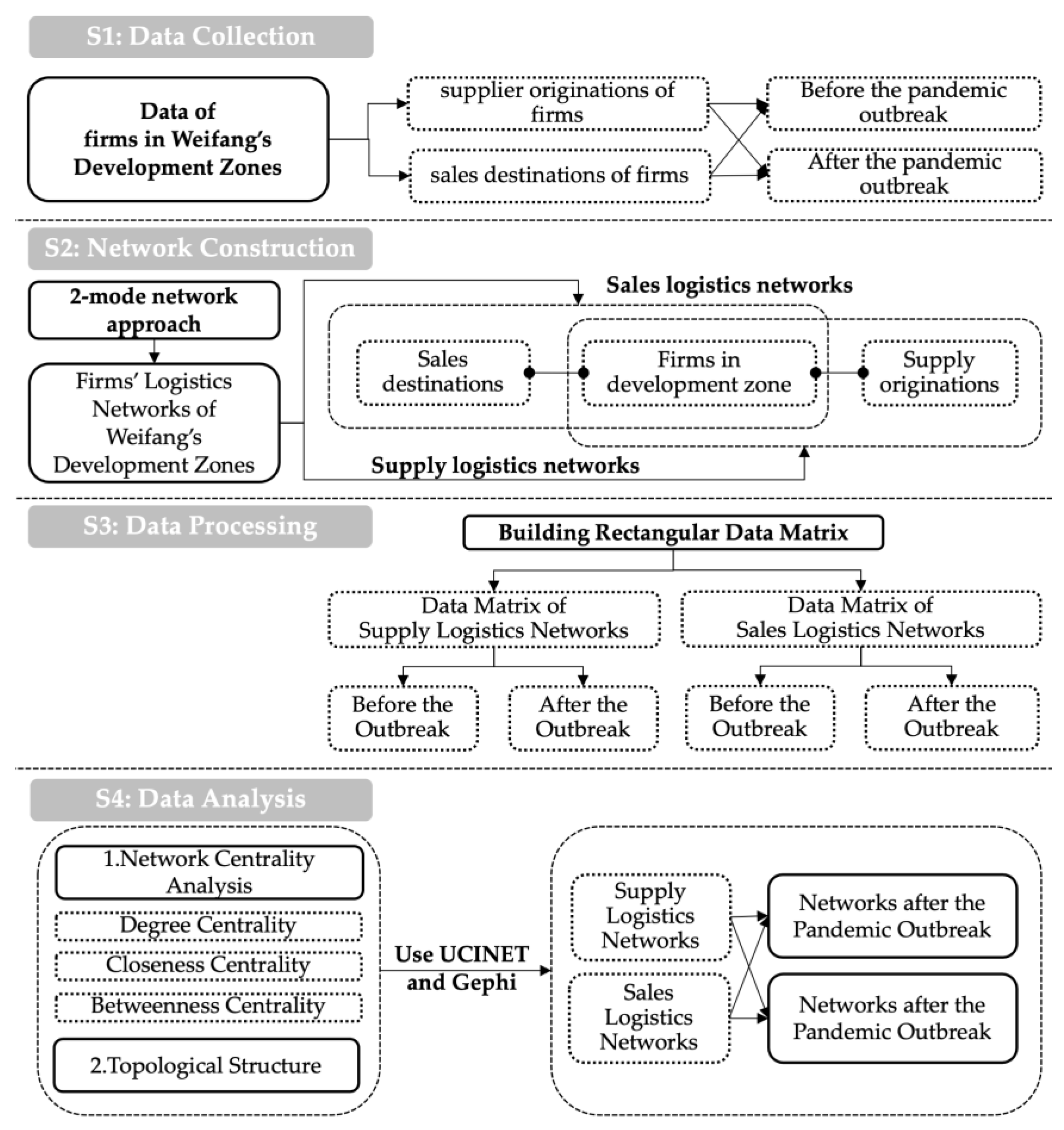
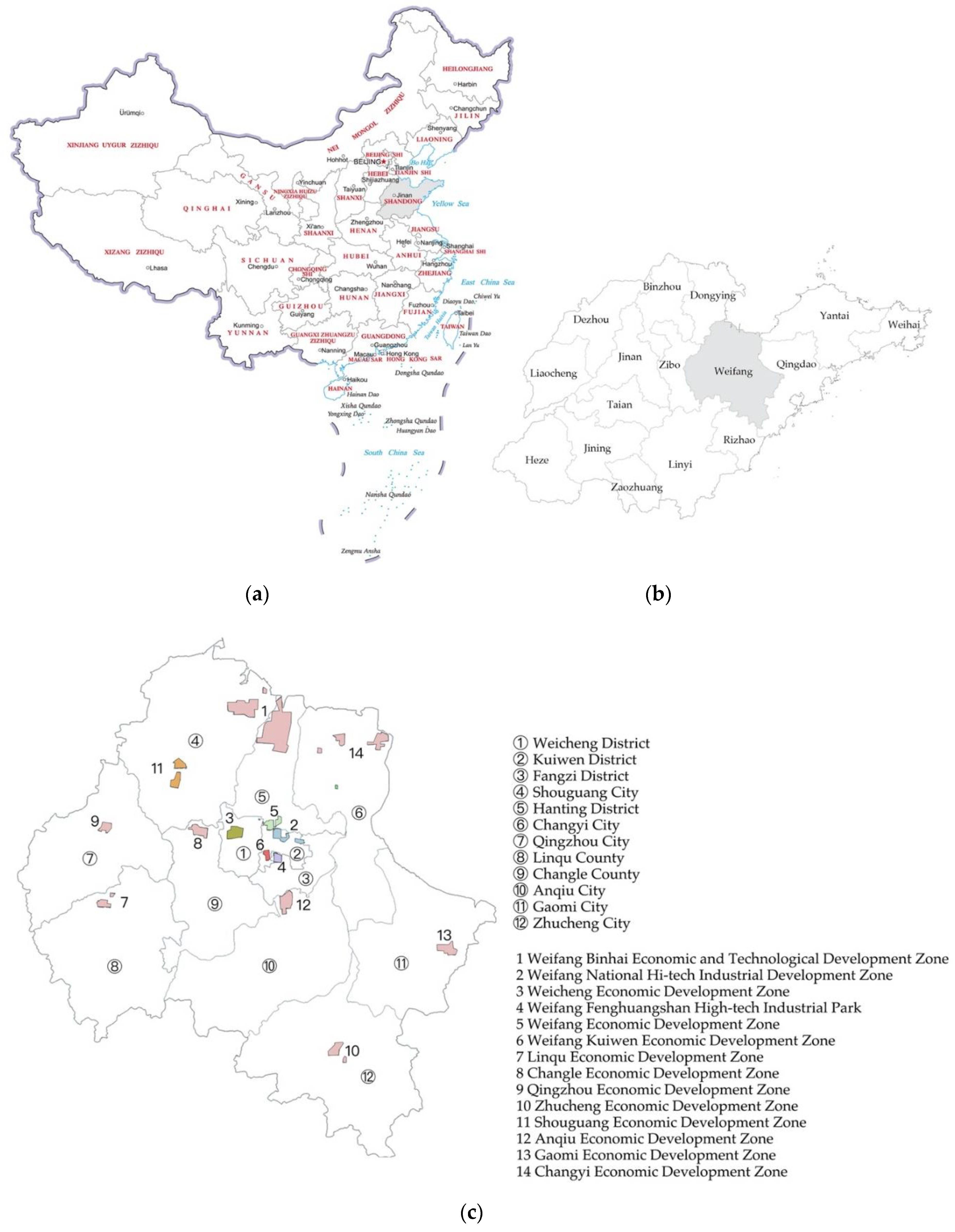


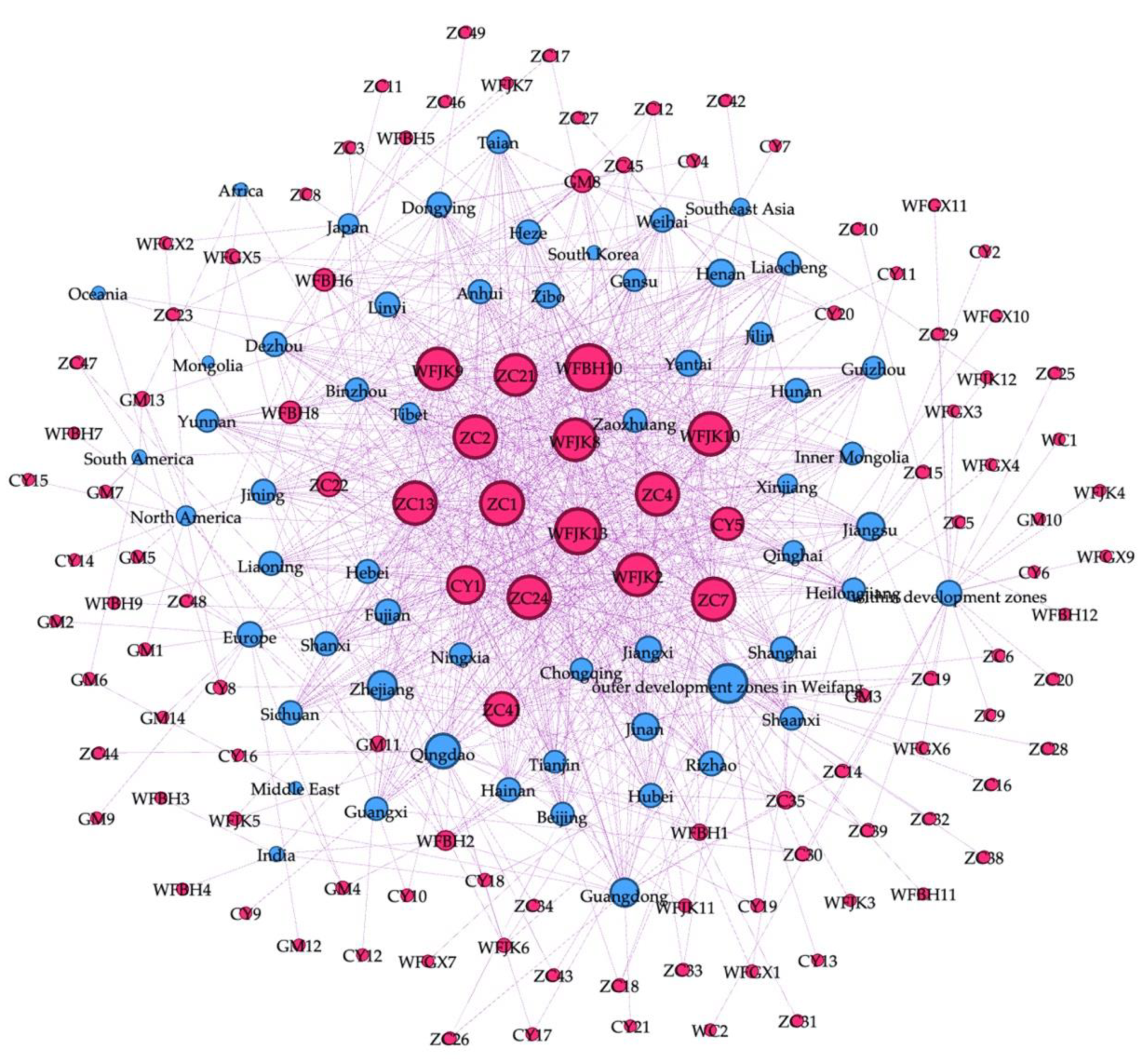


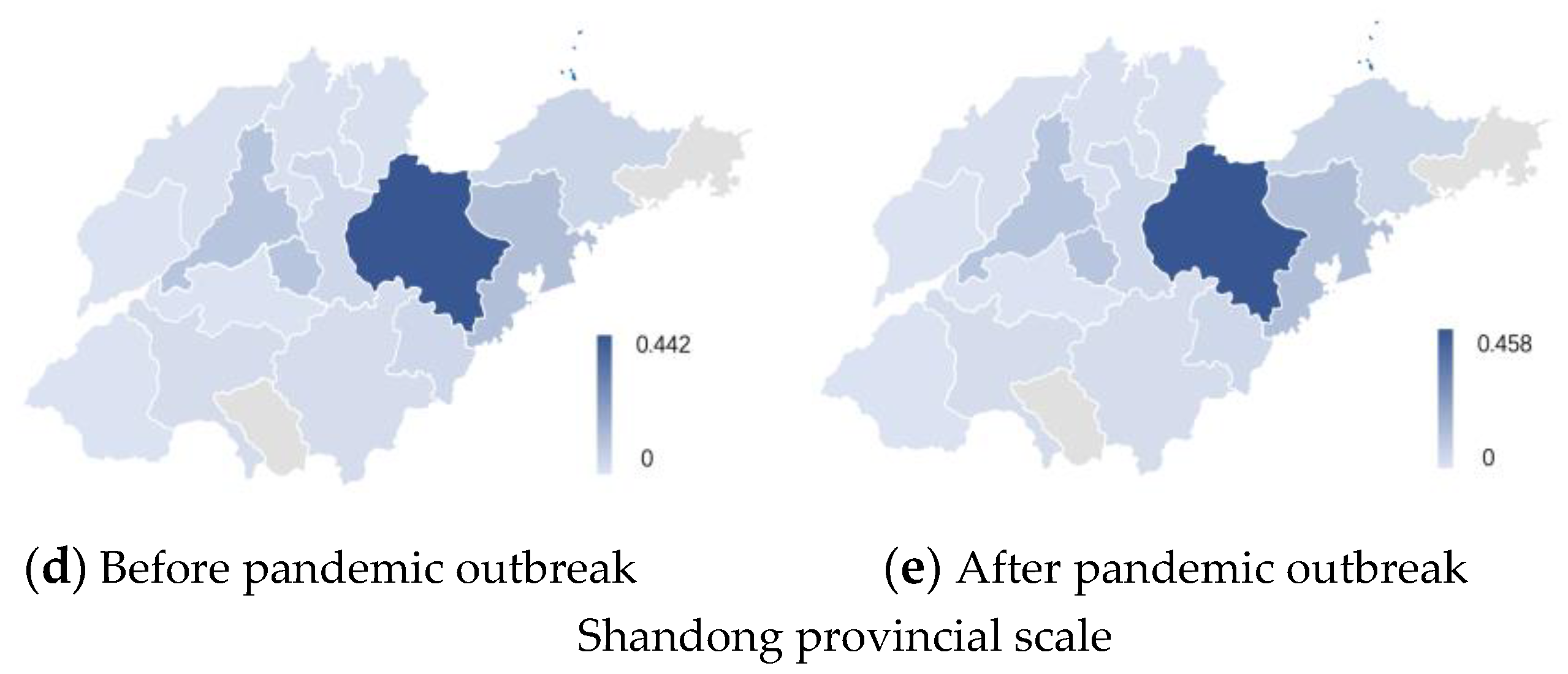

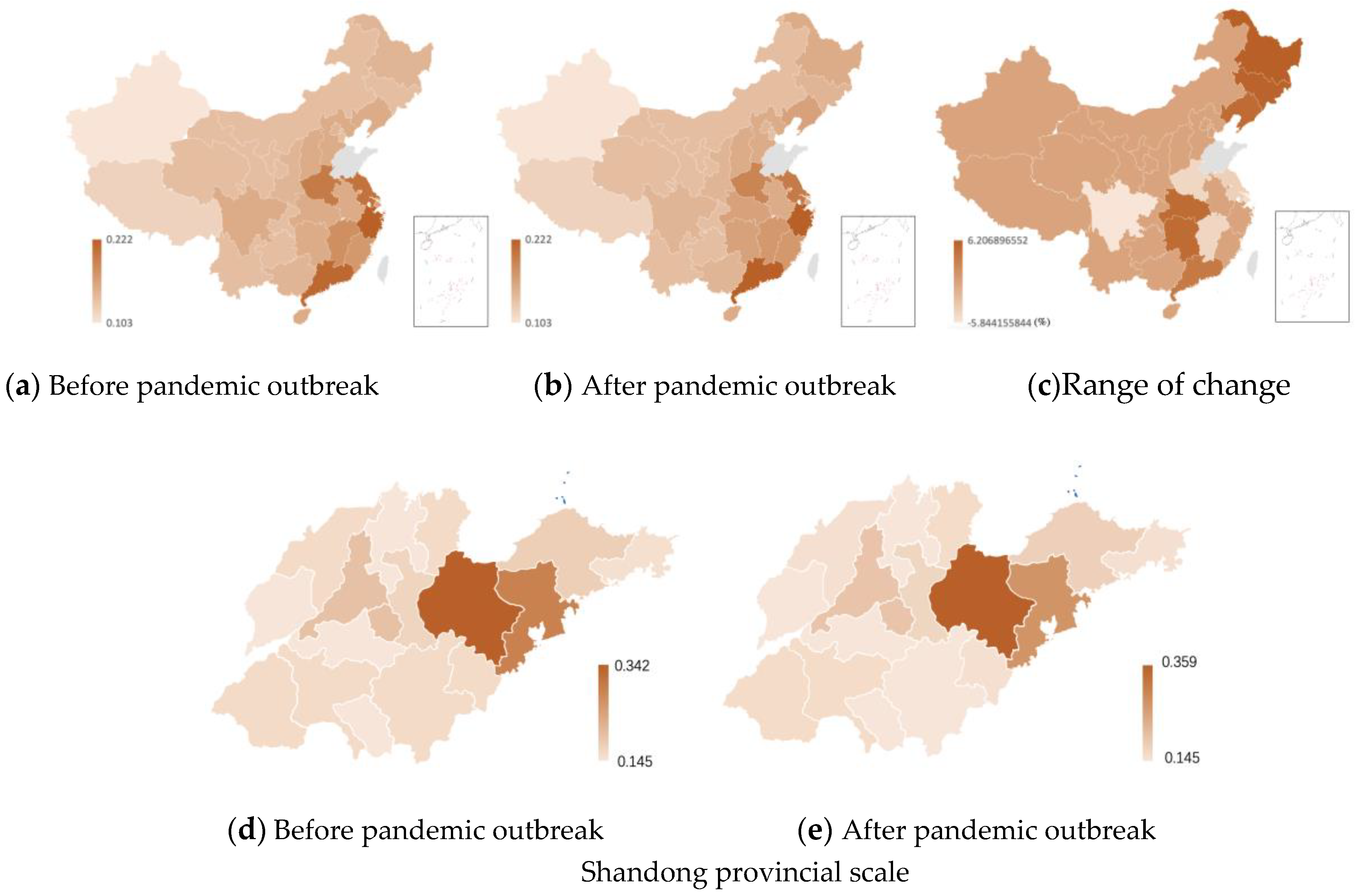

| Name | Level | Approval Date | Approved Area (HA) | Leading Industries |
|---|---|---|---|---|
| Weifang Binhai Economic and Technological Development Zone | National level | April 2010 | 500 | Petrochemical, salinization, equipment manufacturing and logistics |
| Weifang National Hi-tech Industrial Development Zone | National level | November 1992 | 860 | Power equipment, acoustics and optics, life and health care |
| Weifang Comprehensive Bonded Zone | National level | January 2011 | 517 | Electronic information, machinery, new materials |
| Weicheng Economic Development Zone | Provincial level | October 1993 | 353.4 | Energy saving and environmental protection, logistics, equipment manufacturing |
| Weifang Fenghuangshan Hi-Tech Industrial Park | Provincial level | November 1994 | 799.99 | Machinery, equipment, electronic information, agricultural and sideline product processing |
| Weifang Economic Development Zone | Provincial level | May 1994 | 873.84 | New materials, foods, equipment manufacturing |
| Weifang Kuiwen Economic Development Zone | Provincial level | March 2006 | 481.61 | Intelligent manufacturing, logistics, and automobile service |
| Linqu Economic Development Zone | Provincial level | March 1993 | 267.34 | Nonferrous metal processing, equipment manufacturing, foods |
| Changle Economic Development Zone | Provincial level | December 1992 | 974.61 | Equipment manufacturing, papermaking, printing and packaging |
| Qingzhou Economic Development Zone | Provincial level | December 1992 | 192.48 | Equipment manufacturing, energy conservation and environmental protection, biomaterials |
| Zhucheng Economic Development Zone | Provincial level | December 1992 | 159.29 | Machinery, foods, textile services |
| Shouguang Economic Development Zone | Provincial level | December 1992 | 651.25 | Marine chemical, equipment manufacturing, papermaking |
| Anqiu Economic Development Zone | Provincial level | December 1992 | 400.78 | Foods, machinery equipment, petrochemical |
| Gaomi Economic Development Zone | Provincial level | December 1992 | 592.3 | Machinery, textile and clothing, shoemaking |
| Changyi Economic Development Zone | Provincial level | December 1992 | 69.89 | Chemical, machinery, textile |
| Geographical Scale | Supply Source | Before Pandemic Outbreak | After Pandemic Outbreak | ||||
|---|---|---|---|---|---|---|---|
| Degree | Closeness | Betweenness | Degree | Closeness | Betweenness | ||
| Within development zones | 0.292 | 0.62 | 0.239 | 0.3 | 0.611 | 0.25 | |
| Outer development zones in Weifang | 0.442 | 0.696 | 0.356 | 0.458 | 0.692 | 0.372 | |
| Outer Weifang in Shandong | Jinan | 0.1 | 0.521 | 0.065 | 0.108 | 0.516 | 0.07 |
| Qingdao | 0.117 | 0.559 | 0.07 | 0.125 | 0.557 | 0.072 | |
| Yantai | 0.05 | 0.503 | 0.03 | 0.05 | 0.497 | 0.03 | |
| Rizhao | 0.042 | 0.507 | 0.005 | 0.042 | 0.503 | 0.006 | |
| Linyi | 0.025 | 0.489 | 0.004 | 0.025 | 0.485 | 0.004 | |
| Dongying | 0.017 | 0.336 | 0.01 | 0.017 | 0.332 | 0.01 | |
| Binzhou | 0.017 | 0.385 | 0.001 | 0.017 | 0.379 | 0.001 | |
| Dezhou | 0.017 | 0.355 | 0 | 0.017 | 0.349 | 0 | |
| Liaocheng | 0.008 | 0.369 | 0 | 0 | 0 | 0 | |
| Heze | 0.008 | 0.292 | 0 | 0.008 | 0.287 | 0 | |
| Jining | 0.025 | 0.382 | 0.001 | 0.025 | 0.378 | 0.001 | |
| Tai’an | 0.008 | 0.382 | 0 | 0.008 | 0.377 | 0 | |
| Zibo | 0.042 | 0.491 | 0.013 | 0.042 | 0.487 | 0.014 | |
| Outer Shandong in China | Beijing | 0.008 | 0.459 | 0 | 0.008 | 0.452 | 0 |
| Tianjin | 0.017 | 0.422 | 0.002 | 0.017 | 0.416 | 0.002 | |
| Shanghai | 0.017 | 0.495 | 0.005 | 0.017 | 0.487 | 0.004 | |
| Hebei | 0.075 | 0.525 | 0.036 | 0.067 | 0.518 | 0.027 | |
| Liaoning | 0.008 | 0.483 | 0 | 0.017 | 0.481 | 0.003 | |
| Jilin | 0.008 | 0.483 | 0 | 0.017 | 0.481 | 0.003 | |
| Heilongjiang | 0.008 | 0.483 | 0 | 0.017 | 0.481 | 0.003 | |
| Jiangsu | 0.167 | 0.567 | 0.113 | 0.167 | 0.562 | 0.114 | |
| Zhejiang | 0.075 | 0.557 | 0.048 | 0.075 | 0.547 | 0.047 | |
| Anhui | 0.017 | 0.357 | 0.01 | 0.017 | 0.351 | 0.01 | |
| Fujian | 0.025 | 0.412 | 0.002 | 0.025 | 0.407 | 0.002 | |
| Jiangxi | 0.008 | 0.356 | 0 | 0.008 | 0.35 | 0 | |
| Henan | 0.05 | 0.507 | 0.015 | 0.05 | 0.503 | 0.015 | |
| Hubei | 0.017 | 0.485 | 0.002 | 0.017 | 0.481 | 0.002 | |
| Hunan | 0.017 | 0.501 | 0.004 | 0.017 | 0.497 | 0.005 | |
| Guangdong | 0.058 | 0.475 | 0.016 | 0.058 | 0.483 | 0.017 | |
| Hainan | 0.008 | 0.356 | 0 | 0.008 | 0.35 | 0 | |
| Inner Mongolia | 0.017 | 0.485 | 0.01 | 0.017 | 0.481 | 0.01 | |
| Xinjiang | 0.008 | 0.33 | 0 | 0.008 | 0.327 | 0 | |
| Global | Southeast Asia | 0.017 | 0.485 | 0 | 0.017 | 0.378 | 0.01 |
| Japan | 0.033 | 0.472 | 0.022 | 0.025 | 0.462 | 0.013 | |
| South Korea | 0.025 | 0.359 | 0.002 | 0.017 | 0.351 | 0.001 | |
| Europe | 0.008 | 0.33 | 0 | 0.008 | 0.327 | 0 | |
| North America | 0.025 | 0.464 | 0.029 | 0.017 | 0.455 | 0.019 | |
| South America | 0.008 | 0.328 | 0 | 0.008 | 0.326 | 0 | |
| India | 0.025 | 0.445 | 0.01 | 0.025 | 0.44 | 0.01 | |
| Before Pandemic Outbreak | After Pandemic Outbreak | Range of Change (%) | |
|---|---|---|---|
| Within Weifang (Local) | 0.734 | 0.758 | 3.17 |
| Outer Weifang in Shandong | 0.476 | 0.484 | 1.65 |
| Outer Shandong in China | 0.6 | 0.61 | 1.64 |
| Global | 0.141 | 0.117 | −20.51 |
| Geographical Scale | Sales Destination | Before Pandemic Outbreak | After Pandemic Outbreak | ||||
|---|---|---|---|---|---|---|---|
| Degree | Closeness | Betweenness | Degree | Closeness | Betweenness | ||
| Within development zones | 0.171 | 0.394 | 0.14 | 0.179 | 0.53 | 0.126 | |
| Outer development zones in Weifang | 0.342 | 0.605 | 0.234 | 0.359 | 0.603 | 0.219 | |
| Outer Weifang in Shandong | Jinan | 0.197 | 0.522 | 0.028 | 0.197 | 0.552 | 0.034 |
| Qingdao | 0.291 | 0.584 | 0.112 | 0.274 | 0.574 | 0.071 | |
| Yantai | 0.179 | 0.515 | 0.011 | 0.179 | 0.545 | 0.012 | |
| Weihai | 0.154 | 0.509 | 0.004 | 0.154 | 0.537 | 0.004 | |
| Rizhao | 0.162 | 0.511 | 0.007 | 0.154 | 0.537 | 0.005 | |
| Linyi | 0.162 | 0.511 | 0.006 | 0.145 | 0.535 | 0.002 | |
| Dongying | 0.162 | 0.511 | 0.016 | 0.162 | 0.54 | 0.017 | |
| Binzhou | 0.145 | 0.506 | 0.002 | 0.145 | 0.535 | 0.002 | |
| Dezhou | 0.162 | 0.511 | 0.007 | 0.154 | 0.537 | 0.006 | |
| Liaocheng | 0.145 | 0.506 | 0.002 | 0.145 | 0.535 | 0.002 | |
| Heze | 0.162 | 0.511 | 0.008 | 0.162 | 0.54 | 0.008 | |
| Jining | 0.162 | 0.511 | 0.008 | 0.162 | 0.54 | 0.009 | |
| Tai’an | 0.145 | 0.506 | 0.002 | 0.145 | 0.535 | 0.002 | |
| Zaozhuang | 0.145 | 0.506 | 0.002 | 0.145 | 0.535 | 0.002 | |
| Zibo | 0.171 | 0.517 | 0.015 | 0.171 | 0.547 | 0.015 | |
| Outer Shandong in China | Beijing | 0.145 | 0.509 | 0.006 | 0.145 | 0.537 | 0.006 |
| Tianjin | 0.137 | 0.506 | 0.001 | 0.137 | 0.535 | 0.001 | |
| Shanghai | 0.162 | 0.52 | 0.01 | 0.154 | 0.55 | 0.01 | |
| Chongqing | 0.137 | 0.506 | 0.001 | 0.137 | 0.535 | 0.001 | |
| Hebei | 0.154 | 0.544 | 0.016 | 0.154 | 0.54 | 0.008 | |
| Shanxi | 0.154 | 0.513 | 0.008 | 0.154 | 0.542 | 0.008 | |
| Liaoning | 0.154 | 0.511 | 0.01 | 0.162 | 0.542 | 0.012 | |
| Jilin | 0.137 | 0.506 | 0.001 | 0.145 | 0.537 | 0.003 | |
| Heilongjiang | 0.145 | 0.509 | 0.001 | 0.154 | 0.540 | 0.004 | |
| Jiangsu | 0.205 | 0.567 | 0.054 | 0.197 | 0.568 | 0.035 | |
| Zhejiang | 0.222 | 0.536 | 0.053 | 0.222 | 0.577 | 0.061 | |
| Anhui | 0.154 | 0.517 | 0.004 | 0.154 | 0.555 | 0.007 | |
| Fujian | 0.171 | 0.522 | 0.014 | 0.171 | 0.56 | 0.019 | |
| Jiangxi | 0.179 | 0.524 | 0.01 | 0.171 | 0.56 | 0.011 | |
| Henan | 0.197 | 0.524 | 0.03 | 0.188 | 0.552 | 0.029 | |
| Hubei | 0.154 | 0.517 | 0.011 | 0.162 | 0.547 | 0.017 | |
| Hunan | 0.154 | 0.517 | 0.004 | 0.162 | 0.558 | 0.012 | |
| Guangdong | 0.214 | 0.57 | 0.054 | 0.222 | 0.577 | 0.058 | |
| Hainan | 0.154 | 0.517 | 0.004 | 0.154 | 0.555 | 0.007 | |
| Sichuan | 0.154 | 0.511 | 0.006 | 0.145 | 0.537 | 0.005 | |
| Guizhou | 0.137 | 0.506 | 0.001 | 0.137 | 0.535 | 0.001 | |
| Yunnan | 0.137 | 0.506 | 0.001 | 0.137 | 0.535 | 0.001 | |
| Shaanxi | 0.145 | 0.509 | 0.006 | 0.145 | 0.537 | 0.007 | |
| Gansu | 0.137 | 0.506 | 0.001 | 0.137 | 0.535 | 0.001 | |
| Qinghai | 0.137 | 0.506 | 0.001 | 0.137 | 0.535 | 0.001 | |
| Inner Mongolia | 0.137 | 0.506 | 0.001 | 0.137 | 0.535 | 0.001 | |
| Guangxi | 0.145 | 0.541 | 0.012 | 0.145 | 0.537 | 0.004 | |
| Tibet | 0.12 | 0.502 | 0.001 | 0.12 | 0.53 | 0.001 | |
| Ningxia | 0.137 | 0.506 | 0.001 | 0.137 | 0.535 | 0.001 | |
| Xinjiang | 0.103 | 0.494 | 0.001 | 0.103 | 0.519 | 0.001 | |
| Global | Southeast Asia | 0.077 | 0.490 | 0.028 | 0.077 | 0.499 | 0.03 |
| Japan | 0.111 | 0.502 | 0.063 | 0.094 | 0.530 | 0.057 | |
| South Korea | 0.034 | 0.478 | 0.005 | 0.026 | 0.499 | 0.005 | |
| Europe | 0.171 | 0.524 | 0.092 | 0.145 | 0.555 | 0.095 | |
| Middle East | 0.017 | 0.348 | 0.002 | 0.017 | 0.35 | 0.002 | |
| North America | 0.103 | 0.504 | 0.049 | 0.068 | 0.377 | 0.035 | |
| South America | 0.043 | 0.444 | 0.013 | 0.043 | 0.443 | 0.023 | |
| India | 0.043 | 0.362 | 0.022 | 0.034 | 0.36 | 0.012 | |
| Oceania | 0.026 | 0.468 | 0.001 | 0.009 | 0.487 | 0 | |
| Africa | 0.026 | 0.445 | 0.001 | 0.026 | 0.455 | 0.002 | |
| Mongolia | 0.009 | 0.305 | 0 | 0.009 | 0.318 | 0 | |
| Before Pandemic Outbreak | After Pandemic Outbreak | Range of Change (%) | |
|---|---|---|---|
| Within Weifang (Local) | 0.513 | 0.538 | 4.65 |
| Outer Weifang in Shandong | 2.544 | 2.494 | −2.00 |
| Outer Shandong in China | 4.376 | 4.377 | 0.02 |
| Global | 0.589 | 0.477 | −23.48 |
| Within Development Zones | Outer Development Zones in Weifang | Outer Weifang in Shandong | Outer Shandong in China | Global | ||
|---|---|---|---|---|---|---|
| Range of change (%) | Supply | 3.51 | 3.46 | −0.37 | 0.60 | −19.36 |
| Sales | 6.64 | 6.64 | −0.48 | 1.75 | −15.58 | |
| Local | Outer Weifang in Shandong | Outer Shandong in China | Global | ||
|---|---|---|---|---|---|
| Sig. (2-tailed) | Supply | 0.047 | 0.604 | 0.604 | 0.094 |
| Sales | 0.094 | 0.356 | 0.95 | 0.073 | |
Publisher’s Note: MDPI stays neutral with regard to jurisdictional claims in published maps and institutional affiliations. |
© 2021 by the authors. Licensee MDPI, Basel, Switzerland. This article is an open access article distributed under the terms and conditions of the Creative Commons Attribution (CC BY) license (https://creativecommons.org/licenses/by/4.0/).
Share and Cite
Yan, Y.; Wang, X. Global Contraction and Local Strengthening of Firms’ Supply and Sales Logistics Networks in the Context of COVID-19: Evidence from the Development Zones in Weifang, China. ISPRS Int. J. Geo-Inf. 2021, 10, 477. https://doi.org/10.3390/ijgi10070477
Yan Y, Wang X. Global Contraction and Local Strengthening of Firms’ Supply and Sales Logistics Networks in the Context of COVID-19: Evidence from the Development Zones in Weifang, China. ISPRS International Journal of Geo-Information. 2021; 10(7):477. https://doi.org/10.3390/ijgi10070477
Chicago/Turabian StyleYan, Yiran, and Xingping Wang. 2021. "Global Contraction and Local Strengthening of Firms’ Supply and Sales Logistics Networks in the Context of COVID-19: Evidence from the Development Zones in Weifang, China" ISPRS International Journal of Geo-Information 10, no. 7: 477. https://doi.org/10.3390/ijgi10070477
APA StyleYan, Y., & Wang, X. (2021). Global Contraction and Local Strengthening of Firms’ Supply and Sales Logistics Networks in the Context of COVID-19: Evidence from the Development Zones in Weifang, China. ISPRS International Journal of Geo-Information, 10(7), 477. https://doi.org/10.3390/ijgi10070477







